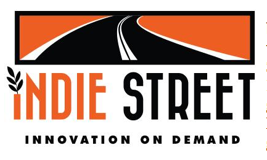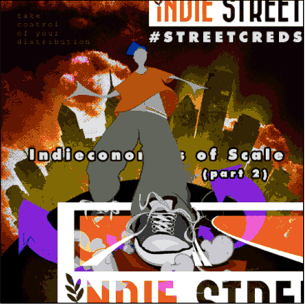By Jay Webb

Previously: IndieStreet Post #3: “Indieconomies of Scale Part 1”
Indieconomies of Scale, Part 2 (of 3): Production Benefits & Vertical Integration
There is one aspect of business that seems to remain constant no matter the advancements in technology: the pressure placed on producers to create better products for less money…the story telling business is surely not immune to this stress. In my opinion, there is no better way to accomplish greater story-telling on smaller budgets then by having a group of filmmakers that are cooperative, competent, but most importantly, alarmingly passionate about the stories being told.
 When considering how to apply business concepts like economies of scale to Independent film, in the case of production we have to reorganize our thought process a little. In this post, we start by treating a small group of Indie filmmakers as a story producing company with each member having both objective story telling capital (skillset, equipment, etc.) and subjective story-telling capital (interest in project, loyalty, emotional connection to material). The more story-telling capital that can be attained through cooperation, the more a group can benefit from production Indieconomies of scale.
When considering how to apply business concepts like economies of scale to Independent film, in the case of production we have to reorganize our thought process a little. In this post, we start by treating a small group of Indie filmmakers as a story producing company with each member having both objective story telling capital (skillset, equipment, etc.) and subjective story-telling capital (interest in project, loyalty, emotional connection to material). The more story-telling capital that can be attained through cooperation, the more a group can benefit from production Indieconomies of scale.
Traditional Production Economies of Scale
Decreasing Costs per unit: When companies look at production economies of scale, they find a wide range of advantages that stem from increasing their production to a certain level. With the growth of a company’s operation, cost per unit will decrease so per unit profit increases.
Production Indieconomies of Scale
Cost per Film (CPF) benefits seen through the eyes of an Indie Filmmaker can be clarified through two types of Indie currency: FAVORS (F) and STORY CAPITAL (SC).
As Favors (F) and Story Capital (SC) increase, CPF decreases and profitability increases.
Sorry for getting all mathematical on ya, but favors can be serious business and can equate to lots of $$$ saved. And anyone who has made an Indie film owes it to hundreds of favors that were offered, or begged for, from people that believed in their story and admired their drive. (whomever invented the Special Thanks credit deserves a special thanks from all of us because your average Aunt or grocery store owner will still think it’s pretty damn cool to see their name in a film’s credits)
When you increase the number of filmmakers in a group, you not only increase the potential for favor currency, you are also increasing your story telling capital. Story telling capital is almost always more valuable in terms of profitability than the monetary equivalent. An infusion of cash might make a budget rise and easily could make a film less profitable if the cash is not used in the most efficient manner. An infusion of story capital through a filmmaker’s knowhow, enthusiasm, or equipment into your project will only raise the potential profits. Subjective story-telling capital, like enthusiasm, may be less tangible, but can actually have a greater effect on profitability than objective capital like skills and equipment. The scarcity of subjective capital for other people’s projects will limit group sizes for co-op productions, This scarcity is also why coming together with like-minded individuals is critical.
Story telling capital beats cash; an example
Simone raises $15K of her budget to cover cinematographer & camera package. She finds Bill the DP, who has experience and fits her budget. His equipment will suffice and he is willing to take on the project, but Bill does not have any genuine interest in the film or passion toward the story. So Simone’s budget goes up by $15K but the story telling capital is not increased greatly, so her Indie film’s profitability may actually decrease from this hire.
In the case where Simone is a part of a small group of filmmakers, she has at least one other story-teller in Rami, who equally admires her work as she does his, especially this current script. Rami just so happens to be an experienced cinematographer. Maybe Rami still needs to rent a camera from a friend, but because he is so ecstatic with this film and the story, his excitement convinces the camera renting friend to give our other Indie film currency, a favor. He cuts them a break on the camera: only $1,000 per week instead of $1500. Rami is not a rich man, and still needs to get paid, but is willing to do the job with all his heart for $850 per week, about half his typical quote for a film of Simone’s size. Now not only has she decreased her budget, but she has an individual behind the camera who is passionate about the story. The bottom line is that if your mini-company of filmmakers grows with individuals that are like-minded and enthusiastic about similar stories, the cost per film unit will drop dramatically and the story will be not only more authentic, but also more profitable.
NOTE: Trying to quantify subjective story-telling capital is not easy, but we feel it should be considered within production hiring and decision making.
Vertical Integration:
Vertical integration is when a company purchases, creates, or otherwise acquires an external part of their production to increase profitability. For example, a micro-brewery might have to pay a shipping company to deliver the beer, a marketing firm to create witty commercials, and a distributor to increase the brand’s reach. Vertical integration may when the micro-brew makes enough income to buy the shipping company, the marketing firm, and maybe even the distributor. This will benefit the beer company for many reasons, but the main being it streamlines its processes and greatly reduces its costs (negotiating prices with yourself typically saves time and money). It’s good to be in the beer business, but what does this have to do with film? We surely can’t afford to BUY a distributor to enjoy these benefits, we don’t even have enough money for post production!
Filmmakers can own more facets of their production process in one very simple way…Learn more. Increase your story-telling capital. As an Indie filmmaker you may not have the funds to purchase but you do have the drive and the passion to vertically integrate and grow your own intellectual property. Acquiring additional skills will not only increase any of your future films’ potential profitability, but it will be exciting. Story-telling is what you love, and each production role is a piece of the story-telling process. The independent world is quickly moving away from specialization. If the trends continue, there may be a day where it will only be profitable to make a character-driven Indie film with a few key crewmembers and actors. If that day comes, you will be ready, sword in hand.
The problems that arise when applying the IndieStreet group distribution model and Indieconomies of scale to production come mainly from scarcity of time. Production takes a concrete time commitment, and while it is paramount to have a solid team, it is not always realistic to expect a specific group to be readily available when a production commences. In the next post we will explore the philosophies that the IndieStreet platform is being built on: the marketing benefits and distribution power that result from a cooperative group effort from direct distributing filmmakers.
I would like to finish this post with a reaction to a comment on our last entry by Ornana films. They recognized that “we need new models and tools to support our post-specialization role in the film community…How can we synergize formerly disparate tasks?”
The answer remains to be seen, but IndieStreet is hoping to help support the community in this trend away from specialization. Also not sure there can be an applicable answer until more artists can shift their philosophy and come to the realization that this is the world we live in. It is understandably difficult for a pure artist to accept that they should have any business thinking about business, or for a born writer/director to want to waste moments they could be story-telling on learning about direct distribution. But this is the world that most of us live in. Most of us will have to convince someone that a film can make money before it gets made. Most of us will be left holding the bag of pushing our film after a distribution company falls short. And most of us do not have a huge nest egg of cash to fall back on if “the whole film thing doesn’t work out.”
Now is the time for artists to dig deep and apply their creativity to the uncomfortable initiatives of learning, collaborating, and positioning themselves through technology for greater reach and artistic impact in the future. Artists are now able to free themselves of greedy middle men by spending time discovering audience platforms and new ways to prolong their art-making careers. IndieStreet wants to be witness to the art and stories of the great artists of this generation, even if it means sacrificing the time it would take for one story to be told or one piece of art to be created. I for one would choose to sacrifice one epic tree falling on deaf ears in exchange for a life reviving forest in the near future.
Next Up: Indieconomies of Scale Part 3: Distribution
Jay Webb – Jay Webb is an independent film producer/writer and small business entrepreneur who has discovered through trial by fire that it is literally impossible for him to choose personal capitalism over passion. Always balancing a life on both sides of the tracks, he has discovered that helping good people succeed (success=happiness) is the core of what drives him. The IndieStreet direct & “group distribution” film initiative is his personal Autobahn.
Web: IndieStreet.com
Twitter: @indiest_films





